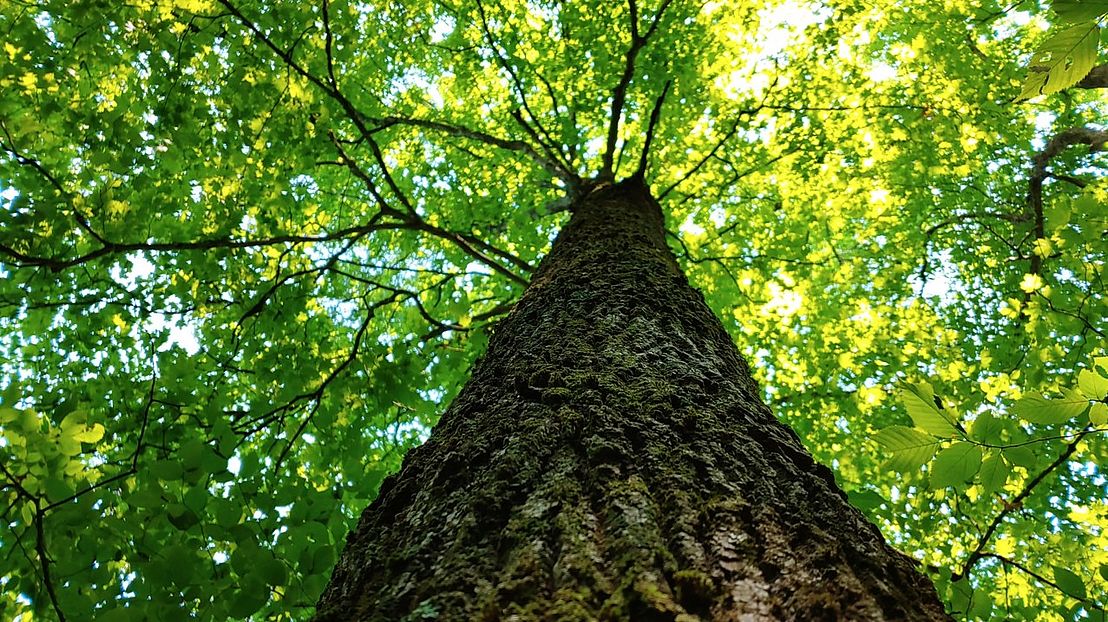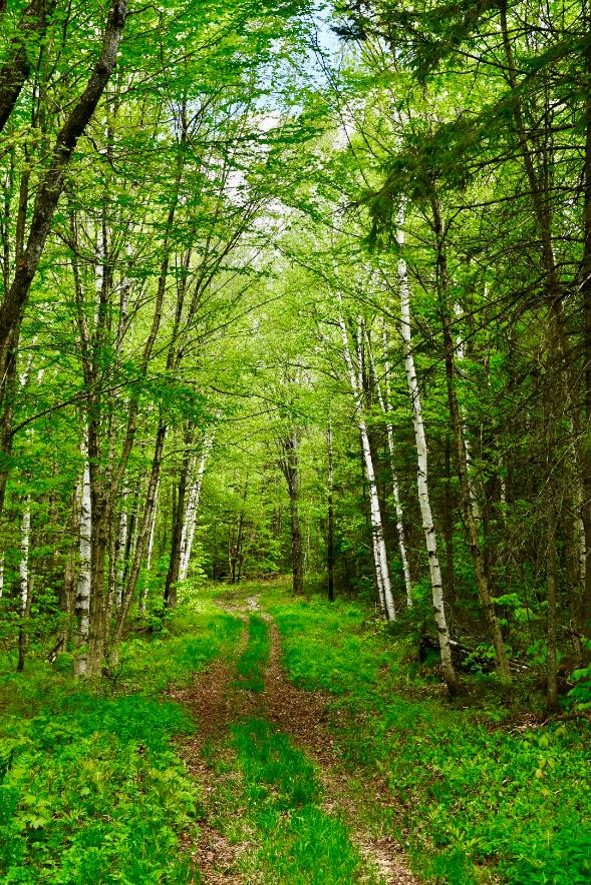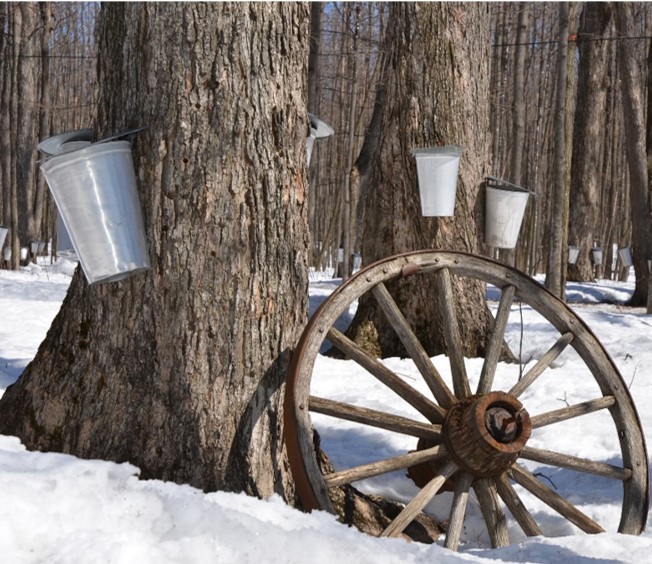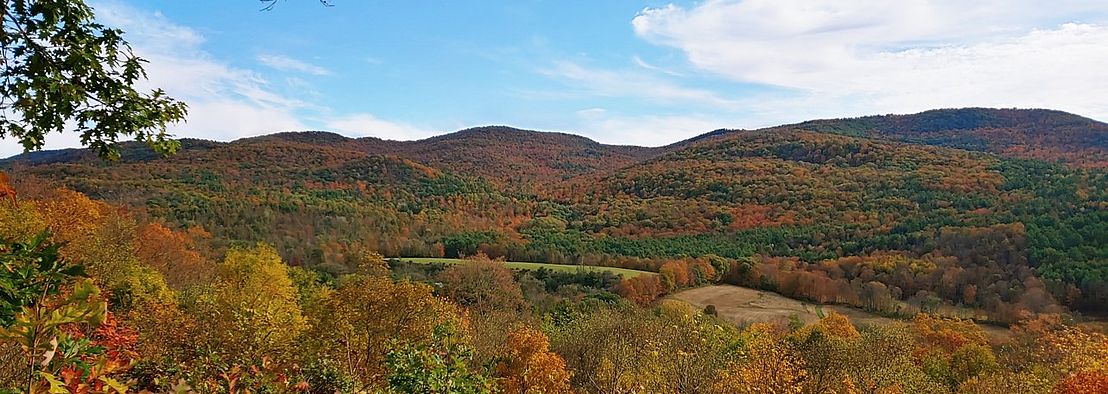Keeping Your Woods Healthy
Through the Years Ahead
This article was written by Alexandra Kosiba, Climate Forester with Vermont Agency of Natural Resources, in partnership with the Northern Institute of Applied Climate Science and Vermont Coverts. It first appeared in publications of these partner groups, and it is reprinted here with permission. Ali visited with our Montgomery Woodlots group this fall and provided a wealth of helpful tips about managing forest land with a changing climate in mind. We're pleased to be able to share a bit of her wisdom with the greater CHC community here!
Whether you spend time outside in your woods, or just enjoy the beauty of your trees and wildlife from your window, you likely love your woods and want to keep them healthy.

Forests are always changing and adapting to new conditions. Some changes are expected like the progression of green summer leaves to the bright red and gold of fall foliage or the annual return of brightly-colored migratory songbirds. Other changes in our woodlands are only visible when comparing differences across many years or decades.
Our climate is changing in ways that humans have never experienced before, resulting in rising temperatures, warmer winters, and shifts in seasonal precipitation patterns. You may be noticing some of these changes in your woods—such as earlier dates for the first signs of spring leaf-out, unusual weather patterns, longer dry periods in summer, or even an increase in fast-growing, nuisance plants such as poison ivy.
A Changing Climate
Vermont’s climate has changed over the course of our lifetimes. Air temperatures are warmer, winters are shorter, and precipitation is often more extreme than it was in the past. Additional changes are expected by the time our grandchildren are having grandchildren of their own:
Temperatures have already warmed by more than 2⁰F since the early 1900s, increasing the length of the growing season and changing the timing of seasonal events like maple sugaring.
Annual precipitation has increased nearly 6 inches across Vermont and is expected to continue rising over the next century. More precipitation is coming during heavy rain events, and higher temperatures result in more rain than snow. This means that stream crossings and culverts will need to accommodate dramatically increased flow at times.
Although the total annual rainfall is increasing, a longer growing season, warmer conditions, and more variable summer rain are likely to increase summer moisture stress. This combination of conditions has the potential to cause harmful droughts.
As the climate conditions change, Vermont is expected to become less favorable to the traditional northern trees we are familiar with. Many common tree species such as balsam fir, paper birch, and red spruce are likely to experience greater stress. Conditions may become more favorable to typically southern species that are now at the northern reaches of their range, including several oak and hickory species.
Take Action in Your Woods
Forests in Vermont already face threats from invasive insects like the hemlock woolly adelgid and emerald ash borer. A changing climate can combine with and increase the effects of existing stressors, like insects and disease, to put your woods at an even greater risk.
There are solutions available to help you and your woods prepare for and cope with the unpredictable conditions that lie ahead. A woodland of healthy, diverse trees can better withstand stress, thereby better supporting the community of plants and animals that live in your woods.
Taking an active role as a steward of your land can help your woodland become more resilient to warmer, drier summer conditions and more frequent disturbances from events such as wind, storms or disease that can damage trees. A licensed forester can help you determine what actions are most suitable for the unique conditions on your land.

Protect water and soils on your land.
Vermont will continue to have larger and more frequent rain events, which could cause wash-outs like you’ve never experienced before. Ensure your culverts and crossings can handle a much larger stream flow than you might expect. Plus, protecting wetlands and buffering streams will help ensure that less of your soil is washed away and avoid filling and choking your healthy streams. A professional can help you anticipate and design appropriate improvements you may need to protect your water sources.
Improve the ability of your trees to resist insects and disease.
Promoting growth of the healthiest, strongest trees in your woodland will help your property to withstand increased threats from pests and disease and also provide a future seed source. Also make sure your forest has a diversity of tree species, so your woods won’t be overly at risk if one particular tree species is harmed.
Prevent and control non-native that threaten native plants and animals.
The changing climate is expected to create even more attractive conditions for undesirable plants that are not native to our area. Unfortunately, these invasive plants often outcompete our native tree species and provide very few benefits compared to native species. Staying on top of these non-native plant threats will help ensure your woods are better prepared for the future.
Promote a diversity of tree species.
Remember that as the climate changes, conditions for current tree species will change too. It’s best to hedge your bets and make sure your woods have a variety of tree species present, so eventual “winners” will be ready to thrive and your woods won’t miss a beat. If you focus on maintaining a single tree species on your property, you run the risk of that species being unable to handle future conditions — and your whole forest loses out.
Promote a diversity of tree ages and sizes.
A diverse forest structure is just as important as the individual species. A woodland that has trees of all the same age or size can also be at risk. Ensuring that you have a good population of young trees, middle-aged trees, and old trees will not only make certain that you’re providing diverse places for wildlife to live today, but it will also mean your woods are ready to handle a variety of situations in the future. Dead wood and downed trees also provide habitat and increase overall forest health.
Protect rare or sensitive plant and animal communities.
Uncommon or fragile plants and animals may have the most difficult time adapting to changing conditions. While we can’t provide absolute certainty that our attention to these natural wonders will protect them into the future, we can give them the best possible chance by removing invasive plants, protecting special features, and sustaining wetlands. Consult with a professional and monitor these situations closely. A forester or wildlife biologist can help you establish a plan to protect these communities.

Consider how your current trees and any trees that you may plant will react to future conditions.
Be thoughtful about what tree species are growing where. For example, a warmer climate may put some species like quaking aspen and eastern hemlock at greater risk while many oak and hickory species may be better adapted to future conditions. That doesn’t mean you need to change the trees in your woods immediately, but you can begin to cultivate your woods for success, like you would gently, but deliberately, tend your garden.
Respond quickly after big disturbance events to help your woods bounce back.
A quick response after a damaging event is very important. If your woodland experiences a sudden pest outbreak, work with a forester to evaluate and control the issue and prevent the threat from spreading further. Similarly, a big storm event might damage a portion of your woodland. Play an active role to make sure it’s ready to recover as quickly as possible by preventing invasive plants, which thrive after disturbances, from outcompeting and killing off native tree seedlings.
Manage damage to young trees from excessive browsing.
Young tree seedlings are the future of the forest — and often the tastiest morsels for your local deer, moose, or other wildlife. By promoting a healthy community of younger trees, you can have more confidence that your woodland will be more adaptable to changing conditions in the future. To prevent browsing, consider managing your wildlife population or enclosing young trees in protective tubes or fencing. A professional can help you find the best solution for your situation.
Monitor your woods and the effect of different management actions.
Regularly keeping an eye on your woods will help you better understand how the changing climate will affect your property. Think about recording annual leaf-out dates. Check for signs of insects or disease on certain trees. Take note of the number and success rate of tree seedlings, as these little trees are the future of your forest.
Get to know other landowners and take advantage of specific expertise.
Landowner associations and conservation partnerships can be a good way to meet other families in a similar position and often provide a forum for discussing common challenges and concerns. It also may be helpful to get connected with professionals with specific expertise who can address questions and assist with your goals for your woods. Government agencies and local conservation organizations may offer some types of assistance at no charge. Consulting foresters, wildlife experts, and legal professionals can provide customized services.

Learn more!
Climate Change in Vermont: https://climatechange.vermont.gov
Our Vermont Woods: www.ourvermontwoods.org
Climate Change Response Framework:www.forestadaptation.org/new-england